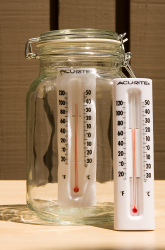
Now that the kiddies are back in school, I’m seeing greatly increased traffic at my Weather Questions website. The most visited page is almost always the one explaining the greenhouse effect. (WARNING: comments posted in response to this article will undoubtedly include a few from people who claim the greenhouse effect is physically impossible, does not exist, etc. )
What amazes me are the number of science education web pages out there which claim to describe experiments that supposedly demonstrate the greenhouse effect using jars or other enclosures.
But these experiments can do no such thing.
There is no simple way to demonstrate the greenhouse effect of a small sample of air experimentally with a jar or any other enclosure because over the scale of inches to feet (or even tens of feet) the effect is so weak it cannot be measured with standard thermometers. (Our friend Anthony Watts tried to replicate one totally bogus experiment promoted by Al Gore and Bill Nye the Science Guy).
Now, the infrared absorption properties of small samples of greenhouse gases can indeed be measured with very expensive spectroscopic equipment in a laboratory, but there is no way I know of to do it with jars or other enclosures and a thermometer.
My favorite atmospheric greenhouse effect experiment that does actually work uses an inexpensive handheld infrared thermometer pointed at the sky. This is the most direct demonstration I know of. The reason it is a “direct demonstration” is that the IR thermometer measures tiny temperature changes within the handheld sensor resulting from changes in the amount of IR energy entering the sensor.
This is exactly what the greenhouse effect does to the surface temperature of the Earth: changes in downwelling IR radiation cause changes in surface temperature. It really is that simple.
(NOTE: Even though handheld IR thermometers are supposedly tuned to work at IR wavelengths where atmospheric greenhouse effects are weak, there is still a residual effect. Besides, even if IR thermometers could completely avoid greenhouse gas effects, they would still be sensitive to the greenhouse effect from clouds. Just point the IR thermometer at the clear sky, and then at a low cloud: the warmer IR thermometer reading from the cloud is due to the greenhouse effect from the cloud. Period. End of argument. QED.)
So, science teachers beware. Those greenhouse effect experiments are junk. Do not try them at home.

 Home/Blog
Home/Blog



